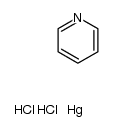trichlorotris(tetrahydrofuran)vanadium
Modify Date: 2025-08-23 12:44:25

trichlorotris(tetrahydrofuran)vanadium structure
|
Common Name | trichlorotris(tetrahydrofuran)vanadium | ||
|---|---|---|---|---|
| CAS Number | 19559-06-9 | Molecular Weight | 229.40600 | |
| Density | 1.312 g/mL at 25ºC | Boiling Point | 40ºC | |
| Molecular Formula | C4H8Cl3OV | Melting Point | 265ºC (dec.)(lit.) | |
| MSDS | Chinese USA | Flash Point | 18 °F | |
| Symbol |



GHS02, GHS05, GHS07 |
Signal Word | Danger | |
| Name | trichlorotris(tetrahydrofuran)vanadium |
|---|---|
| Synonym | More Synonyms |
| Density | 1.312 g/mL at 25ºC |
|---|---|
| Boiling Point | 40ºC |
| Melting Point | 265ºC (dec.)(lit.) |
| Molecular Formula | C4H8Cl3OV |
| Molecular Weight | 229.40600 |
| Flash Point | 18 °F |
| Exact Mass | 227.90800 |
| PSA | 9.23000 |
| LogP | 2.86530 |
| Vapour Pressure | 152mmHg at 25°C |
|
Section 1: Product Identification Chemical Name:Vanadium (III) chloride tetrahydrofuran adduct CAS Registry Number:19559-06-9 Formula:VCl3(C4H8O)2-3 EINECS Number:none Chemical Family:metal halide Synonym:Vanadium trichloride tetrahydrofuran adduct
Section 2: Composition and Information on Ingredients IngredientCAS NumberPercentACGIH (TWA)OSHA (PEL) Title Compound19559-06-9100%no datano data Section 3: Hazards Identification Corrosive to skin and eyes. May release toxic and corrosive fumes of hydrogen chloride and aqueous Emergency Overview: hydrochloric acid. Tetrahydrofuran can cause drowsiness and unconsciousness. Primary Routes of Exposure:Ingestion, inhalation, skin, eyes Eye Contact:Severe corrosive to the eyes. Exposure can lead to permanent eye damage. Skin Contact:Corrosive to skin. Contact can lead to redness, pain, blistering, ulceration, and scar formation. Inhalation of tetrahydrofuran vapor may cause coughing, nausea, dizziness, headache, drowsiness, and Inhalation: unconsciousness. Ingestion:Ingestion of tetrahydrofuran or hydrogen chloride may cause gastrointestinal and respiratory irritation. Inhalation of vapor induces drowsiness and may cause coughing, chest pains, difficulty in breathing, nausea, Acute Health Affects: dizziness, headache and unconsciousness. Hydrogen chloride can cause pulmonary edema. Chronic Health Affects:In animal studies tetrahydrofuran acted as a tumorigen (liver), mutagen and reproductive effector. NTP:No IARC:No OSHA:No SECTION 4: First Aid Measures Immediately flush the eyes with copious amounts of water for at least 10-15 minutes. A victim may need Eye Exposure: assistance in keeping their eye lids open. Get immediate medical attention. Wash the affected area with water. Remove contaminated clothes if necessary. Seek medical assistance if Skin Exposure: irritation persists. Remove the victim to fresh air. Closely monitor the victim for signs of respiratory problems, such as difficulty Inhalation: in breathing, coughing, wheezing, or pain. In such cases seek immediate medical assistance. Seek medical attention immediately. Keep the victim calm. Give the victim water (only if conscious). Induce Ingestion: vomiting only if directed by medical personnel. SECTION 5: Fire Fighting Measures Flash Point:not applicable Autoignition Temperature:none Explosion Limits:none Extinguishing Medium:carbon dioxide, dry powder or foam If this product is involved in a fire, fire fighters should be equipped with a NIOSH approved positive pressure Special Fire Fighting Procedures: self-contained breathing apparatus. Hazardous Combustion andIf involved in a fire this material may emit toxic fumes of hydrogen chloride, carbon monoxide, carbon dioxide, Decomposion Products:and organic fumes. Unusual Fire or Explosion Hazards: No unusual fire or explosion hazards. SECTION 6: Accidental Release Measures Small spills can be mixed with powdered sodium bicarbonate, lime, or calcium carbonate and swept up. Avoid Spill and Leak Procedures: raising dust. SECTION 7: Handling and Storage Store solid in a tightly sealed container away from moisture. Handle in a fume hood under a dry atmosphere of Handling and Storage: air or nitrogen. Prolonged exposure to the atmosphere may degrade the product. SECTION 8: Exposure Controls and Personal Protection Eye Protection:Always wear approved safety glasses when handling a chemical substance in the laboratory. Skin Protection:Wear protective clothing and gloves. Consult with glove manufacturer to determine the proper type of glove. Ventilation:The solid may form corrosive vapors. It should be handled in an efficient fume hood. If in form of fine dust and ventilation is not available a respirator should be worn. The use of respirators Respirator: requires a Respirator Protection Program to be in compliance with 29 CFR 1910.134. Ventilation:The solid may form corrosive vapors. It should be handled in an efficient fume hood. Additional Protection:No additional protection required. SECTION 9: Physical and Chemical Properties Color and Form:red xtl. Molecular Weight:157.3 Melting Point:no data Boiling Point:no data Vapor Pressure:no data Specific Gravity:no data Odor:pungent odor Solubility in Water:reacts with water SECTION 10: Stability and Reactivity Stability:moisture sensitive (store cold) Hazardous Polymerization:no hazardous polymerization Conditions to Avoid:contact with moisture Incompatibility:Water, alcohols, oxidizing agents, oxygen and active metals Decomposition Products:Vanadium oxychloride, hydrogen chloride, carbon dioxide, carbon monoxide, organic fumes. SECTION 11: Toxicological Information RTECS Data:No information available in the RTECS files. Carcinogenic Effects:no data Mutagenic Effects:no data Tetratogenic Effects:no data SECTION 12: Ecological Information Ecological Information:No information available SECTION 13: Disposal Considerations Disposal:Dispose of according to local, state and federal regulations. SECTION 14: Transportation Shipping Name (CFR):Corrosive solids, N.O.S. Hazard Class (CFR):8 Additional Hazard Class (CFR):NA Packaging Group (CFR):II UN ID Number (CFR):UN# 1759 Shipping Name (IATA):Corrosive solid, N.O.S. Hazard Class (IATA):8 Additional Hazard Class (IATA):NA Packaging Group (IATA):II UN ID Number (IATA):UN# 1759 SECTION 15: Regulatory Information TSCA:Not listed in the TSCA inventory. SARA (Title 313):See category code N770 for reporting. Second Ingredient:none SECTION 16 - ADDITIONAL INFORMATION N/A |
| Symbol |



GHS02, GHS05, GHS07 |
|---|---|
| Signal Word | Danger |
| Hazard Statements | H228-H302 + H312 + H332-H314 |
| Precautionary Statements | P210-P280-P305 + P351 + P338-P310 |
| Hazard Codes | C: Corrosive;F: Flammable; |
| Risk Phrases | 20/21/22-34-40-11 |
| Safety Phrases | 26-27-28-36/37/39-45-23-16 |
| RIDADR | UN 2925 4.1/PG 2 |
| WGK Germany | 3 |
| Packaging Group | III |
| Hazard Class | 8 |
| Vanadium(III) chloride-tetrahydrofuran complex (1:3),0.5M solution in methylene chloride,AcroSeal |
| VANADIUM(III) CHLORIDE-TETRAHYDROFURAN C OMPLEX (1:3),0.5M SOLN IN CH2CL2 |
| Vanadium(III) chloride-tetrahydrofuran complex |
| Vanadium(III) chloride-tetrahydrofuran complex (1:3) solution |
| MFCD00145515 |
| VANADIUM (III) CHLORIDE TETRAHYDROFURAN ADDUCT |
| [VCl3(tetrahydrofuran)3] |
| Vanadiumchloridetetrahydrofuranadductredxtl |
| trichlorotris(tetrahydrofuran)vanadium(III) |
| VANADIUM(III) CHLORIDE TETRAHYDROFURAN COMPLEX (1:3) |
| [VCl3(thf)3] |
 CAS#:7440-62-2
CAS#:7440-62-2 CAS#:363-72-4
CAS#:363-72-4 CAS#:25377-37-1
CAS#:25377-37-1 CAS#:12185-35-2
CAS#:12185-35-2 CAS#:12129-72-5
CAS#:12129-72-5